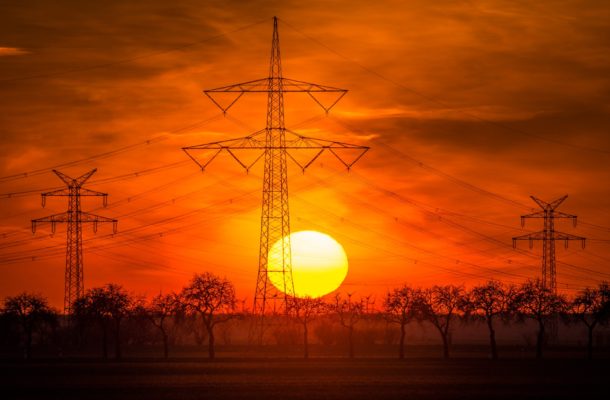Is massive transmission investment required to support a renewable grid?

In China, the US, Germany and the rest of Europe, large investments are being made in large cross country HVDC and HVAC grids with capacities up 4 GW and voltages up to 1MV. In Australia there is only one significant HVDC line, the 500MW Basslink. There is some 500kV AC transmission in Victoria and NSW but the vast area of the NEM is serviced at voltages between 66kV and 330kV.
So, it is argued that we must also need more high voltage transmission. However our circumstances are quite different.
Australia is rich in local wind sources
In Germany for example, most of the wind resources are in the North. The best winds are in the North Sea, 600-800 km north of the demand centres between Stuttgart and Munich. The three southernmost states of Germany occupy 40% of the area of Victoria and use as much power as the whole NEM.
In China the best wind, hydro and solar sites are 2,000-3,000 km from the coastal provinces ranging from Shandong to Guanxi. In the US, it’s 1,600 km from wind rich Oklahoma to Florida, 2,000 km from Kansas to New York and 1,100 km from Wyoming to California. At one end of each of these lines are vast wind resources, at the other end huge demand for supply.
By contrast, in Australia the excellent wind resources around Goulburn and Bathurst are only 120-160 km from Sydney and it’s just 190 km from Tamworth to Newcastle. In Victoria the proposed Star of the South windfarm at is only 180 km from Dandenong. In Australia there are good wind resources within 200 km of every population centre.
The most difficult case is the coastal strip and surrounding area from Newcastle to Wollongong. That area uses about 50,000 GWh per year and if wind was to supply 40% of NSW electrical energy, it would have to supply 20,000 GWh into those regions. Modern 4MW class wind turbines generate 10-20GWh per year and so, at an average of 12 GWh, that means about 1,600-1,800 wind turbines would be required.
Across Scotland there is an average of one wind turbine for every 15 square km. In Germany there is one for every 12. This includes all the land in these countries unsuitable for wind turbines, from cities, transport and military areas to lakes, mountains and scenic views.
If an Australian turbine is erected for every 25 square km – half the density of Germany – there is room for 3,600 turbines within 180 km of Newcastle to Port Kembla. If there was enough storage, wind alone, within 180 km of the load, could easily supply all power for that region.
Texas, which is 13% smaller than NSW, will generate between 65 and 75TWh from wind this year and is installing more turbines all the time.
Solar power could meet our needs
Then there is solar. NREL produced an extensive study, based on 2013 demand patterns, that showed the US could produce 39% of its electricity requirements by employing 16% efficient solar cells on approximately 14% of its roof area. California, with a similar climate and economic structure to NSW, could produce 73% of its demand from rooftop solar.
Since that report, demand has fallen, and solar panel efficiency is gradually increasing. The report’s figures imply that if solar panels reached 22% efficiency and NSW was as energy efficient as California, then rooftop solar alone could supply all of NSW’s electricity demand.
A more recent study by Deloittes showed that rooftop solar could provide 1.2 MWh/y per square km of land area in the Netherlands. The coastal area of NSW mentioned above only uses about 0.5 MWh per square km. Its annual insolation is about 4.8kWh/day/sqm, compared to 2.7 in the Netherlands, and so rooftop solar could conceivably produce double the area’s power needs.
Similar calculations can be made for other Australian states or regions. In Broken Hill, for example, a combination of various solar plants, a relatively high penetration of rooftop solar and the Silverton wind farm means more than 80% of the town’s energy needs can be generated within 60 km, reducing the need to transmit power 1,000 km from coal plants near the coast. The addition of another wind or good sized solar farm could make Broken Hill a net exporting region.
Local storage instead of long distance transmission
If we can generate all the energy we need locally, then why do we need long distance HV transmission at all? It is a question of balance, the more localised generation is, the more variable it is, hour to hour, season to season, therefore the more storage is required.
Alternatively, by connecting disparate generation and varying loads then the need for more storage is reduced. A solar dependent suburb can be supplied by wind and hydro or even biomass at night. Even within a neighbourhood, an off-grid house would probably need 10kW of solar and 30-40kWh of batteries, but because usage patterns vary a group of 100 houses probably only needs 700kW of solar 250kWh of batteries, reducing the required investment by a third.
While the current large-scale generation system produces energy and cost imbalances between regions and so requires major long-distance transmission infrastructure, there is no demonstrated need for that provision to expand. Why transmit power from the Hunter to Broken Hill when wind power in Broken Hill is now cheaper than a new coal plant, let alone the cost of transmission?
Sales of electricity from Victoria to South Australia have already fallen and regions like Port Augusta, Mildura to Bendigo, the Northern Rivers in NSW and the Cairns/Atherton Tablelands can easily generate more power than they need. Over time the transmission grid will gradually shift from bulk transfers to a balancing system. Already the Basslink is barely profitable and within 2 years, as new wind and solar comes on line in Tasmania, it is likely that power flows will fall even further.
Does South Australia need power from NSW?
Another example is offered by the proposed transmission lines from NSW to South Australia. It is estimated that a new 1GW line would cost $2.5b, however NSW already has inadequate reserve margins and so on many occasions it could not transmit any significant power to South Australia. On a still night, when the turbines aren’t turning, South Australia may provide some demand for NSW power but that is not a big market.
As transmission costs from Hunter Valley and black coal generation both cost more than Victorian brown coal and transmission from the Latrobe Valley, why in all but the rarest occasions would South Australia buy NSW power? Even if the Victorian supply is actually from Tasmanian or Snowy hydro, it is still cheaper than Hunter Valley coal.
In practice, it would be far cheaper for South Australia to invest in 1,000MW/6,000MWh of local storage as this would cost about half the interconnector and provide much greater security and resilience for the state.
The question down the track for places like Broken Hill, Mildura and Northern Rivers – and even Gladstone and Port Augusta – will be whether to uprate transmission links to export even more power as there is plenty of potential to do so. They could also de-rate the main transmission lines and install local storage to save losses and maintenance or develop more energy intensive industries, adding value to local minerals and agricultural products using solar process heat and cheap solar PV and wind electricity.
Whatever the future holds, a combination of more locally produced renewable energy and distributed storage across the country will obviate the need for the coal fired stations and long power lines of the past.
Peter Farley is the President of the Victorian Vernier Society and former Deputy President of the Victorian Committee of Engineers Australia. He has also served as a Director of the Inner Melbourne VET Cluster for more than a decade.















Alan Stevenson
March 24, 2018 at 8:33 am
I have just installed a photo-voltaic system for under $5,000. So far this device has consistently produced more power than we use daily. I pride myself on keeping up with current technology but was still surprised at this result. I am beginning to think that the slow take-up of photo voltaics is because of a low knowledge base. Maybe we should look harder at teaching the average Aussie about the advantages and various types available. Surely it would not be too difficult to get groups in each suburb to install, thus cutting down on the need for more power lines.
Amelia
March 24, 2018 at 4:45 pm
It’s crazy that a country as sunny as Australia doesn’t mandate solar power panels be added to every new building. There’s a huge amount of new construction in the cities as populations increase and small houses are redeveloped into unit blocks. If developers had to install proper solar panels and battery storage into every new house and unit block, just like they have to provide enough parking, then residents would save money, outages would be a thing of the past, energy costs would fall and a big environmental and power headache would get a lot easier to solve.